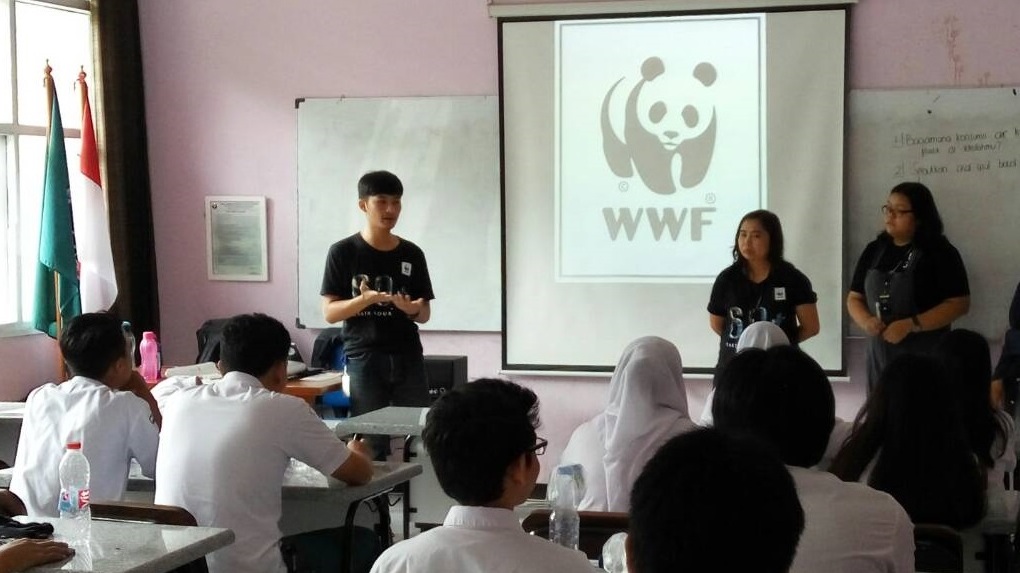PANDA MOBILE INTRODUCES UMBRELLA ANIMALS IN PERSON AND THROUGH MODULES
I cut down the tall trees so that the sunlight can enter the lush forest. My body weight is able to make plant seeds enter the soil so that they can grow and develop. The remaining seeds that stick to my feet will be scattered as I roam widely. My dirt can be a natural fertilizer for the Earth's lungs.
Hello, my name is Raisha. I am currently pursuing higher education at a private university in Jakarta. Apart from studying, I have also been actively volunteering with WWF-Indonesia's Panda Mobile since 2018. Through this article, I would like to share my experience of working with Panda Mobile for almost two years, especially as part of the Panda Mobile Module development team.
One of the most memorable "lessons" that I always tell in schools is about how elephants protect forest ecosystems. Up until now, I only knew that elephants have a wide range of range, making them one of the umbrella animals. As it turns out, elephants also do a lot for the forest. Elephants are ecosystem balancers. Every day, it explores the vast forest. Along the way, the elephant's strong legs coupled with its heavy body weight are able to step on plant seeds into the soil so that new plants can develop. In addition, plant seeds attached to the elephant's feet are also likely to be released in other parts of the forest. This means that elephants are also spreading different types of plants. In addition, elephant dung and urine are also natural fertilizers for the forest.
Elephants also act as forest controllers. If trees grow too tall, sunlight is blocked and inhibits the growth of lower plants and life on the forest floor. The elephant's role is to trim the tall trees with its trunk, so that sunlight can still enter the forest.
As one of the umbrella animals that plays a major role in the survival of the forest, elephants are featured as one of the special themes in the Panda Mobile Module. This integrated module, consisting of 12 themes, contains the Panda Mobile activity plan, recommendations for supporting films and interactive games related to the theme, as well as a summary of important materials that will be delivered by volunteers during the activity. The module, which is designed with attractive images and illustrations, is expected to become a "pocket book" for facilitators, and a reference for the inviting party (school teachers, corporations, and others) to be able to determine what themes Panda Mobile wants to present during activities. Thus, the event will be held with better preparation.
Being part of developing such an important module was completely new to me, let alone compiling a module, or even writing a journal, because such things involve a long research process and need to be comprehensive. When I was first offered to join the drafting team, I was both excited and hesitant. I was happy because I was given a great deal of trust, and unsure whether or not I would be able to do it. I realized that an opportunity like this would not come twice and it would be a shame to miss it. I finally accepted the offer.
My colleagues were my brothers from WWF-Indonesia's Engagement Activation Team. In addition, there was also another volunteer who was also studying like me, except that he was a final year student majoring in veterinary medicine who automatically had a lot of knowledge about animals. I was even more scared and insecure because my knowledge about animals and the environment was based on empirical experience, materials from various trainings with WWF, and a little bit from National Geographic programs. Certainly, among the team that developed the module at that time, I was the most knowledgeable.
Turns out, my fear, insecurity, and all my worries disappeared since the first meeting at the WWF office. My colleagues assured me that they would help, and that we were here to learn together. Sure enough, the drafting process was fun and very memorable for me. The discussion and preparation of this module lasted quite a short time, about four or five months. Meetings, discussions, reviews, and evaluations from various parties were conducted for each material, to really distill and consider what information could be included in each chapter.
Much of the new material I got from discussions and listening to stories from older siblings who had worked directly in the field. For example, the story behind the rescue of a Borneo rhino named Pahu, complete with a song created during the rescue process. I absorbed these materials and conveyed them as much as possible to the participants of Panda Mobile activities. In addition to compiling the materials, we were also challenged to create new interactive and interesting games for elementary school students, in addition to the existing activities in the Panda Mobile activity series. The final stage of module development is evaluation with an editor. I learned a lot from this evaluation. For example, tips on writing that is systemic and easy to understand. After going through the editing process and being approved by the editor, the module was then handed over to the design team for further processing.
Being part of the Panda Mobile module development team gave me many new lessons and experiences. I also became more confident in delivering conservation materials in front of the Panda Mobile participants. I hope this module can become a new standard in Panda Mobile activities. Hopefully, the facilitators and invitees will find the information in the module helpful. For new volunteers or those of you who intend to sign up to be part of the Panda Mobile activities, keep up the good work! I hope this opportunity for self-development is open to you too. Greetings!





